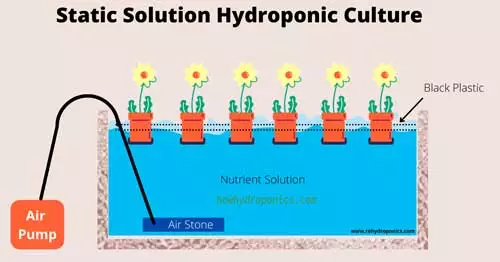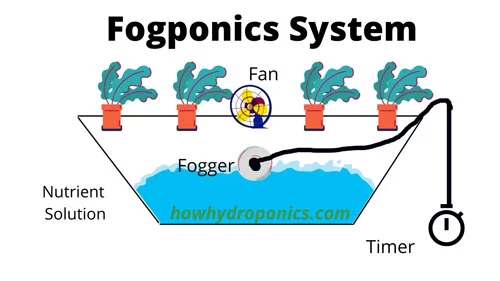In this article, we are going to discuss the various types and techniques used in hydroponic agriculture. By now you must be equipped with a basic understanding of what hydroponics is and how it works. Now we will be diving deep into the mechanics of hydroponics and its different types.
As we already discussed, hydroponics can be grown within small spaces with water mixed with nutrients without any need for soil. So, it now boils down to the fact that how are you using these components and what is the availability of these components in your area of place you live. Let’s look at some of the most popular hydroponic systems out there.
Types of Hydroponic Systems
Static solution culture
Static solution culture is a type of hydroponic farming where your plants and crops are grown in a static container or tubs (in case of home setup) otherwise in big plastic containers having holes on them to put the plant roots in contact with the hydroponic nutrient solution. This solution is aerated with some mild oxygen so that plants don’t die.
Here I have created a simple to understand diagram for you guys of the Static solution culture.

If the solution is un-areated, the roots of the crops are kept a little above the solution so that they can get enough oxygen for better growth. The formation of algae is prevented by covering the container with aluminium foil, cardboard, black plastic, butcher paper, etc.
Continuous-flow solution culture (NFT)
As evident from the name itself, in this hydroponic system, we use a constant flow of nutrients that keeps passing through the roots of the plants. This method is often used by large scale hydroponic farms where they grow it mostly for commercial purposes.
It is very easy to control the components such as the temperature, pH level and the number of nutrients going into the system as they can be first resolved in a larger tank before sending it out to the plants.

A very famous variation of this technique is called the Nutrition film technique or NFT. NFT is a very efficient form of hydroponic farming as a shallow film of nutrient solutions flows past through the plant roots which are mostly in the air. This creates a perfect mix of oxygen, water, and nutrients.
Aeroponics
As the word suggests, aeroponics is the method of growing plants and crops using air. Well, that’s not the full definition, plants are suspended in the air in a controlled environment and they are sprayed with a nutrient-rich mist periodically to be able to grow faster and better. So there is no need to hold huge volumes of water to grow plants with the help of aeroponics. This is a slight variation of the hydroponic system.
Research from NASA has shown that only 25% of nutrients are required to grow a plant aeroponically as compared to hydroponics. Richard Stoner invented this technology and commercialized it in 1983 and since then aeroponics is considered a better alternative to hydroponics especially in regions where there is water shortage.
Also Read “How to Start Hydroponic Seeds“
Fogponics
This is a type of aeroponics where instead of using pressurized nozzles for spraying out the nutrients suspended in the air in a controlled environment, an ultrasonic frequency modulator is used to generate nutrient diffusions of 5-10 micrometres (10-6 meters).

This diffused solution is the air is then absorbed by the roots of the plants and makes it easier for the plants to do so without creating a hindrance on their oxygen channels.
Passive sub-irrigation
This technique is called passive because the flow of nutrients is regulated automatically through the capillary action of the roots and the porous inert medium. It is also called passive hydroponics or hydroculture because there is no need to actively monitor the nutrient input or any other thing for that matter.
If I were to make you understand it in simple words then this is how it works. You take a simple pot, fill it with inert(un-reactive) medium for example expanded clay or coconut peat, put the plant/seed, and pour some nutrient solution into the pot, not fully but just a small amount so that it can be sucked up by the plant as and when required.
The advantage of a passive hydroponic system is that the roots get more direct oxygen through the air and due to low levels of nutrient solution it creates good humidity due to evaporation.
Ebb and Flow Hydroponic System
This technique also comes under the sub-irrigation method of hydroponics farming. The Ebb and Flow hydroponic system use a nutrient reservoir and a plant tray arranged in such a way that a cycle is formed and our plants are being regularly hydrated with the nutrient solution with the help of an electronically operated pump.

The Ebb and Flow method is also called the flood and drain method because you keep on flooding the plants with nutrients and then draining them. This cycle keeps on repeating until we have our fully grown strawberries or lettuce or whatever that you are growing.
We will talk about this system in detail in the upcoming articles as this is the most efficient way to grow hydroponic vegetables at your home.
Run-to-waste
Run-to-waste is called so because of its ability to turn the nutrient solution to waste as it passes through the inert media in which the hydroponics grow. At a low level of complexity, this system uses a manual process of applying the nutrient solution to the inert medium ( for ex. Coconut coir, Rockwool, perlite, etc).
For larger hydroponic systems or in commercial hubs an automated pump with a timer can also be used to run the cycle.
The Run-to-waste system was first used in Bengal in 1946 India and is also known as “The Bengal System”. This system can be highly efficient and environmentally friendly as the nutrient-rich waste can be collected and filtered to be used again and again making it a very cost-effective method of hydroponics farming.
Deep water culture
This method is mostly used by beginners and people who are just stepping into the field of hydroponics as it is a low cost and low complexity method and it’s a DIY hydroponic system too. You just have to get the components and drop your plant into the nutrient solution. That’s it. It’s so simple.
Also Read “Best Method To Grow Hydroponic Lettuce At Home“
Well, there are things to be taken care of like the nutrient solution should be oxygenated either with the help of a pump or porous stone or both. Also, the plant needs to be put into a pot hanging onto a lid so that the roots are being suspended in the solution.
Rotary
This is a bit more complex system of hydroponics mostly used by professionals or someone who is really a hydroponics enthusiast. In this mechanism, a circular frame is used which rotates around a high intensity grow light. The pots are fixed at the sides and the frame is rotated periodically, mostly controlled by a timer.

Because of natural reasons, the plants grown with this method tend to grow bigger and longer as compared to horizontal growth due to their constant fight with gravity. As the plants take much less space, more quantity can be produced with a lot less area with the rotary method of hydroponic farming.


